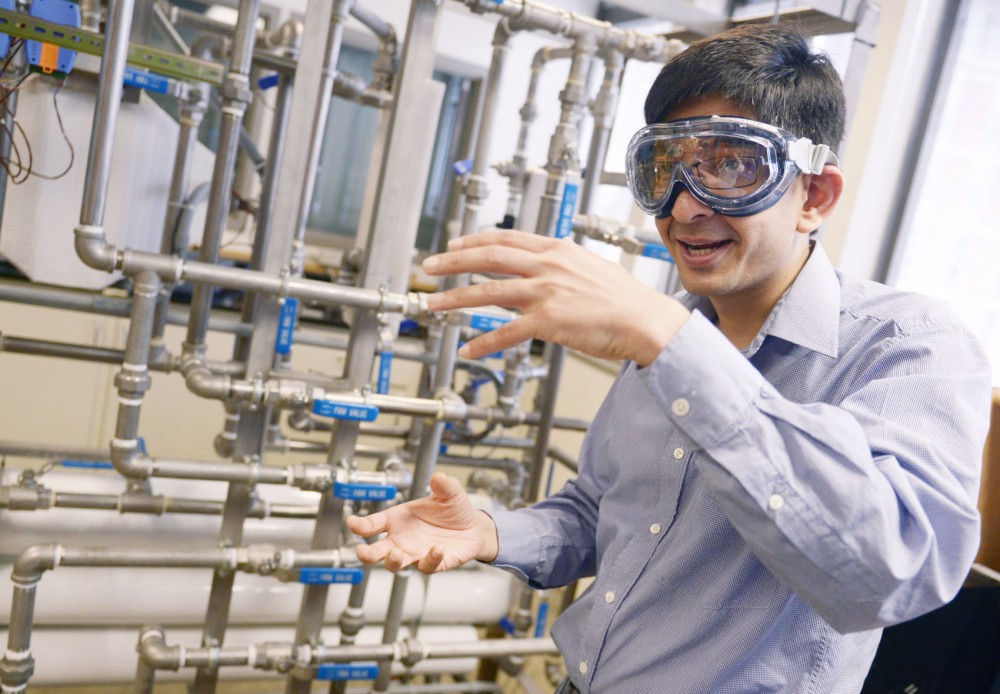The University of Minnesota’s chemical engineering major is pushing its limits, and many students say the major’s higher demand has increased its difficulty.
Although designed to accommodate about 100 seniors, the major has admitted 30 percent more students over the last several years, which is putting space constraints on the curriculum.
Department head Frank Bates said the nationally ranked major can’t keep growing and still offer the same caliber of education.
“The department has swelled to accommodate as many as we can,” he said, “but there’s a limit to what we can do.”
All of the College of Science and Engineering undergraduate majors have grown, said Paul Strykowski, associate dean for undergraduate programs.
Lab space is the most challenging thing to plan, Bates said, because there are only so many hours in the day to schedule time for the students to use the space.
“You can put more students in a lecture hall,” Strykowski said, “but if you really want to get a one-on-one laboratory experience, at some point, something’s got to give.”
Lab space
If chemical engineering students fail a course that’s a prerequisite for subsequent courses — like capstone labs — they have to take the class over again.
As one of the most “restrictive” majors in CSE, students take almost all of their upper division classes together in succession. Most classes are only offered once a year, so students have to wait a full year to retake them.
Students take two capstone classes during their junior and senior years. It’s often the first time they are applying what they learn in lectures to actual industrial-grade equipment, like the double-effect apparatus, which is a maze of pipes with 63 different valves.
Students get two four-hour sessions in the lab for each experiment. The first attempt often doesn’t produce any usable data, and they have to wait until the next week for the final attempt.
Tyler Lillemo, chemical engineering junior, said if this happened in “the real world,” he wouldn’t give up and leave.
“I feel like the class is a little unrealistic because they only give you two tries to get it right,” he said. “If I was in a job and I didn’t get it right, I would not go home at five.”
Students are in groups of three, and they come in at assigned times, so the lab is booked solid every week. Many students said they wished there was more lab time or space for them to perfect their experiments.
Construction started on Amundson Hall last month, which will add 40,000 square feet of teaching and lab space. But most of the expansion will provide more space for the other major in the department, materials science and engineering.
Bates said he expects to see materials science grow in size and prestige, equaling chemical engineering. He hopes to graduate about 100 seniors from each major per year.
Raul Caretta, head professor of the lab courses, said the small lab groups result in a very low student-to-teacher ratio, which is crucial in courses as difficult and precise as the labs.
The department uses “team teaching,” Bates said. Multiple faculty members teach lecture, discussion and lab portions of the courses. At least five or six faculty members teach the capstone labs.
Caretta said the faculty members have the same high standards throughout the course because they want their engineers to keep improving with the same expectations.
“We are trying to start up engineers that will make the least amount of mistakes,” he said.
Pressures
Chemical engineering juniors spent 40 hours or more writing their 50- to 80-page lab reports for the junior lab.
The average grade on the hardest lab was 26 percent.
Students described the grading as “demoralizing.” Their final grades are based on a curve, so if they get above average, they can feel safe that they’ll pass the two-credit class.
U.S. News and World Report ranked the University’s chemical engineering major the fifth-best in the country.
CSE students apply to their major sophomore year. Strykowski said this allows students to get a taste of the different disciplines in the college before committing to a major.
In fall 2010, 206 sophomores were enrolled in Material and Energy Balances, the pre-major chemical engineering course. Of these students, 136 of them went on as juniors, and about 130 of them will graduate this year.
Caretta said it’s the department’s policy to admit as many students into the labs that qualify to register for the course, which means they have to pass the junior lab in order to proceed to the senior one.
Bates stressed how the faculty has to prepare the students for “the real world.” When engineers make mistakes, he said, the results are often devastating.
“In the real world … you don’t get partial credit for getting it halfway right,” Bates said. “This course is challenging for students, partly because we expect perfection.”
Mikayla Kienitz, chemical engineering junior, said she’s become “numb” when getting her grades back.
“They grade you with the standard of perfection,” said chemical engineering junior Kristi Gangelhoff, “but you aim for average.”
These are high standards for students who are often in their first industrial-scale engineering lab, said Zach Erdman, chemical engineering junior.
“It should be expected when you have the necessary knowledge base,” he said, “not when you’re first learning it.”
As frustrated as students are while they’re taking the classes, Caretta said their hard work does pay off after they graduate.
“They don’t realize how good they are getting,” he said, “but we don’t tell them too much either … because engineering is a life learning experience.”


